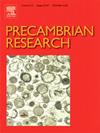Dynamics of Marinoan-age glaciers in NW Tarim, China
IF 3.2
2区 地球科学
Q2 GEOSCIENCES, MULTIDISCIPLINARY
引用次数: 0
Abstract
Glaciers were pivotal agents in shaping Cryogenian landscapes through erosional and depositional processes. Subglacial erosional forms serve as critical archives of glacial dynamics and thermal regimes, offering insights into paleoenvironmental interpretation and paleogeographic reconstruction. Cryogenian subglacial erosional forms are preserved on seven cratons globally, with China’s excellent example located in the Aksu-Wushi area of the northwestern Tarim Craton. A series of well-preserved erosional features of subglacial origin crop out, which until now have not been subject to systematic description or interpretation. This is redressed herein, and eight sites are surveyed in detail, enabling considerable insight into and unintegrated that have hindered research on Cryogenian glacial dynamics. In the Aksu-Wushi area, striations, grooves, p-forms, roches moutonnées, and glacial plucking morphologies, testify to both abrasion and meltwater processes at the ice-bedrock interface. A southwest-directed ice flow, with gradual southward deflection, is identified. Subglacial erosional forms and the overlying sedimentary successions documented in this study jointly reveal the depositional environmental evolution of the Yuermeinak Formation from subglacial to proglacial to post-glacial transgression, forming a complete record of continental ice sheet advance-retreat processes. The dynamic patterns and thermal regime of the Marinoan glacier further provide critical constraints for paleogeographic reconstruction. The consistent ice flow directions and sedimentary evolution observed in both the Yuermeinak Formation (Tarim) and Walsh Formation (Australia) collectively suggest that the Tarim was likely adjacent to the Australia during the Cryogenian period. The subglacial erosional forms and striated clasts at Aksu-Wushi area indicate a temperate glacial thermal regime during the latter stages of the snowball Earth event, compatible with a mid- to low-latitude paleogeographic setting. The massive gravel-bearing sandstone and siltstone with dropstones between the basal diamictite and overlying Ediacaran cap dolomite represents large-scale chemical weathering at the end of temperate glacier. Thus, paleo-glaciology can play a vital role in deep time paleogeographic reconstructions.
塔里木盆地西北部马里诺世冰川动力学
冰川是通过侵蚀和沉积过程塑造低温期景观的关键因素。冰下侵蚀形式是冰川动力学和热状态的重要档案,为古环境解释和古地理重建提供了见解。全球有7个克拉通保存着冰冻期冰下侵蚀形态,中国塔里木克拉通西北部的阿克苏-乌什地区就是一个很好的例子。一系列保存完好的冰下成因侵蚀特征显露出来,迄今为止还没有得到系统的描述和解释。本文对这一问题进行了解决,并对8个地点进行了详细调查,使人们对阻碍低温期冰川动力学研究的问题有了更深入的了解。在阿克苏-乌什地区,条痕、沟槽、p形、岩洞和冰川撕裂形态证明了冰-基岩界面的磨损和融水作用。确定了一个西南方向的冰流,并逐渐向南偏转。研究记录的冰下侵蚀形态和上覆沉积序列共同揭示了Yuermeinak组从冰下-冰前-冰后海侵的沉积环境演化,形成了完整的大陆冰盖进退过程记录。马里诺冰川的动力模式和热状态进一步为古地理重建提供了关键的约束条件。塔里木的Yuermeinak组和澳大利亚的Walsh组一致的冰流方向和沉积演化表明塔里木在冰川期可能与澳大利亚相邻。阿克苏-乌什地区的冰下侵蚀形态和条纹碎屑显示了雪球地球事件后期的温带冰川热环境,与中低纬度古地理环境相适应。大块含砾石的砂岩和粉砂岩,其落石介于基底二晶岩和上覆埃迪卡拉盖帽白云岩之间,代表了温带冰川末期大规模的化学风化作用。因此,古冰川学可以在深时古地理重建中发挥重要作用。
本文章由计算机程序翻译,如有差异,请以英文原文为准。
求助全文
约1分钟内获得全文
求助全文
来源期刊

Precambrian Research
地学-地球科学综合
CiteScore
7.20
自引率
28.90%
发文量
325
审稿时长
12 months
期刊介绍:
Precambrian Research publishes studies on all aspects of the early stages of the composition, structure and evolution of the Earth and its planetary neighbours. With a focus on process-oriented and comparative studies, it covers, but is not restricted to, subjects such as:
(1) Chemical, biological, biochemical and cosmochemical evolution; the origin of life; the evolution of the oceans and atmosphere; the early fossil record; palaeobiology;
(2) Geochronology and isotope and elemental geochemistry;
(3) Precambrian mineral deposits;
(4) Geophysical aspects of the early Earth and Precambrian terrains;
(5) Nature, formation and evolution of the Precambrian lithosphere and mantle including magmatic, depositional, metamorphic and tectonic processes.
In addition, the editors particularly welcome integrated process-oriented studies that involve a combination of the above fields and comparative studies that demonstrate the effect of Precambrian evolution on Phanerozoic earth system processes.
Regional and localised studies of Precambrian phenomena are considered appropriate only when the detail and quality allow illustration of a wider process, or when significant gaps in basic knowledge of a particular area can be filled.
 求助内容:
求助内容: 应助结果提醒方式:
应助结果提醒方式:


